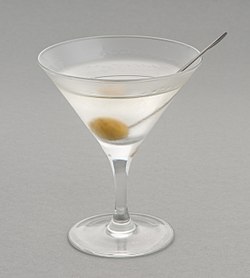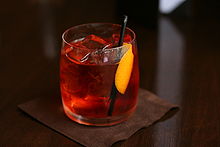Bartending terminology

Various unique terminology is used inbartending.
Definitions and usage
[edit]
Straight, up, and straight up
[edit]Inbartending,the terms "straight up" and "up" ordinarily refer to an alcoholic drink that is shaken or stirred with ice and then strained and served in astemmed glasswithout ice.[1][2]"Straight" ordinarily refers to a single, unmixedliquorserved without any water, ice, or othermixer.In this sense, "straight" can sometimes be used as a synonym foreither"straight up" or "neat".[2]
Furthermore, "straight" is also aterm of artfor a particular type ofwhiskey produced in the United States.United States federal law defines the term "straight whiskey"as whiskey that has met particular requirements for its ingredients, production process, and aging.[3]For example, the label of a bottle oftop-shelfbourbontypically identifies the product as "Kentucky straight bourbon whiskey" (since about 95% of all bourbon is produced inKentucky).[4]
While the meaning of "up" and "neat" is ordinarily clear, some clarification may be needed for "straight" and "straight up", to determine whether the spirit is intended to be chilled and strained or served undiluted at room temperature.[2]
Neat
[edit]A drink served "neat" is a single, unmixedliquorserved without being chilled and without any water, ice, or othermixer.[1][2]Neat drinks are typically served in arocks glass,shot glass,snifter,Glencairnglass, orcopita.
On the rocks
[edit]
"On the rocks" refers to liquor poured overice cubes,and a "rocks drink" is a drink served on the rocks. Rocks drinks are typically served in arocks glass,highball glass,orCollins glass,all of which refer to a relatively straight-walled, flat-bottomed glass; the rocks glass is typically the shortest and widest, followed by the highball which is taller and often narrower, then the Collins which is taller and narrower still.
Garnish
[edit]"With a twist" signals the bartender to add a "twist"of thezestof acitrusfruit (bar choice, if unspecified) to the cocktail. Often, the bartender will hang the rind of the citrus on the glass as agarnish.
Cocktails
[edit]Cocktailsare generally served chilled, although some (e.g.,margaritas) may be served either with or without ice, and this must be specified. Cocktails can be served "frozen", which is with crushed ice or blended with ice instead of cubes. "Hot Toddy" drinks are cocktails served hot as the name implies.
Unmixed liquors may be served either neat, up, or on the rocks, with differing conventions. High-qualitywhiskyand other aged liquor are most often served neat, while lower-quality whisky is usually served with a mixer or on the rocks.Vodkacan be stored as a liquid well below the freezing point of water because of its high proof and low particulate content, and cocktails made with sub-freezing vodka are sometimes requested to minimize the amount of added water from melted ice during shaking.
Chaser
[edit]A shot of whisky,tequila,or vodka, when served neat in a shot glass, is often accompanied by a "chaser" (a mild drink consumed after a shot ofhard liquor) or a "water back" (a separate glass of water). These terms commingle as well; it is common in many locales to hear a "beer back" ordered as the chaser to a shot. A drink may specifically be ordered "no chaser" as well.
InIsrael,a chaser is simply a smaller version of a shot.[5]
In thePhilippinesandCanada,"chasers" are beverages, mostly sweet ones, that are drunk immediately after downing a shot to relieve the bitter taste or strong kick of the alcohol.[6]
A relatively new type of chaser is called "pickleback"wherein a shot of liquor is chased by a shot of pickle brine.
Other terms
[edit]- Bartender’s spoon:A spoon, usually at least 30 cm (12 in) long, very often with a spiralled handle, holding between a dash (about.46 ml) and1⁄4US fl oz (7.4 ml), and used for stirring cocktails and measuring ingredients. The other side often ends with a fork for poking fruit out of a syrupy dessert.[citation needed]
- Dash:1⁄8th teaspoon (about.46 ml)
- Salty rim: A glass with asalty rimis used for cocktails in which it is desired to enhance the drink's taste with saltiness. Examples include themargaritaand thesalty dog(which without the salty rim is aGreyhound).[7]The rim of the glass is wetted with, e.g., a lime wedge, and then the glass is rubbed against a surface on which salt has been poured, so the salt will stick to it.
- Shaken: Aerated and textured.
Well and top-shelf
[edit]Drinks establishments will often have a lower-priced category of drinks, known as "well drinks"or" rail drinks ", and a higher-priced category known as"top-shelf"or" call "drinks, and will useupsellingby offering the higher-priced category when taking orders. The terms come from the relative positions of the bottles of spirit used for the drinks; the cheapest version of a spirit offered by a bar is typically stored in a long rail or "well" making it readily available to a busy bartender, while the more expensive, better-quality liqueurs and spirits are displayed on shelves behind the bar where they attract patrons to the available selection.
Sizes
[edit]Alcoholic beverages are sold in a wide variety of sizes, for example:
- A "pony"is slang for one US fluid ounce (30 ml) of spirit, while in the US the standard-size" shot "of alcohol is a 1.5-US-fluid-ounce (44 ml)" jigger ", with a" double "being three US fluid ounces (89 ml).
- A "middy",commonly known as a" pot "inQueenslandandVictoria, Australia,is 10 imperial fluid ounces (284 ml).
- A "schooner"may refer to various glasses forbeer,typically of size 15 imperial fluid ounces (426 ml) in Australia, or2⁄3imperial pint (379 ml) in theUnited Kingdom.
- A "pint"or half-pint is the universal measure for draft beer in the UK 20 imperial fluid ounces (568 ml).
Rather than use measuring equipment, professional bartenders usually use a pour spout inserted into the mouth of the bottle, which restricts the flow of liquid to a standard rate allowing reasonably accurate time-based pours. For instance, a "6-count" is a common analogue for a 1.5oz jigger, which can be trained to by having the bartender upend the bottle (with pour spout installed) and counting to 6 out loud as quickly as the words can be said clearly. This method breaks down into convenient sub-measures; each count is approximately one-quarter fluid ounce, making a "pony" 4 counts and a "half-jigger" 3 counts. This system is not perfect because liquids of differentviscositieswill pour at different rates through the same spout, but it does allow consistent pours from drink to drink for a consistent result from each bartender, while being much faster than using a thimble measure or similarspirit measure.
See also
[edit]References
[edit]- ^abWalkart, C.G. (2002).National Bartending Center Instruction Manual.Oceanside, CA: Bartenders America, Inc. pp. 104, 106.ASINB000F1U6HG.
- ^abcd"Up, Neat, Straight Up, or On the Rocks",Jeffrey Morgenthaler, Friday, May 9, 2008
- ^"Standards of Identity for Distilled Spirits, Title 27 Code of Federal Regulations, Pt. 5.22(b)(1)(iii)"(PDF).Archived fromthe original(PDF)on 2008-12-17.Retrieved2019-08-03.
- ^"Bourbon Facts".Kentucky Distillers' Association.Retrieved2019-08-03.
- ^"Drinking in Israel: Arak (ערק)".Halfway Anywhere.2013-04-11.Retrieved2021-09-20.
- ^"Guide to the Philippines Drinking Culture: Inuman & Pulutan Favorites".Guide to the Philippines.2020-09-18.Retrieved2021-12-10.
- ^"Recipe:: Salty Dog Cocktail".Stylish Spoon. 10 March 2008.Retrieved2019-07-24.

